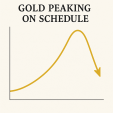Don’t tell the ECB, but gold shines as faith in global bonds wavers
NEW YORK (May 25) It was an interesting week for gold, which ended with a nearly 5% gain as investors questioned the stability of global bonds amid rising concerns over unsustainable sovereign debt.
Two disappointing bond auctions rattled financial markets. Japan saw its worst 30-year bond auction in decades, pushing yields above 3.2%. Later that day, the U.S. held a weak 20-year bond sale, sending the 30-year yield to 5%.
Typically, bond yields rise during periods of economic strength, when investors prefer riskier assets like equities. However, today's rising yields are driven not by growth, but by fears that governments may never repay their mounting debts.
This shift in sentiment is bolstering gold. Despite offering no yield, gold’s appeal lies in its stability. It’s a globally recognized monetary asset with no geopolitical or counterparty risk—nobody’s liability. That’s why organizations like the London Bullion Market Association and the World Gold Council (WGC) are pushing to have it recognized as a high-quality liquid asset.
Yet, a recent research paper from the European Central Bank (ECB) has cast a shadow, warning that renewed investment demand for gold could actually destabilize markets.
“Should extreme events materialise, there could be adverse effects on financial stability arising from gold markets. This could occur even though the aggregate exposure of the euro area financial sector appears limited compared with other asset classes, given that commodity markets exhibit a number of vulnerabilities. Such vulnerabilities have arisen because commodity markets tend to be concentrated among a few large firms, often involve leverage, and have a high degree of opacity deriving from the use of OTC derivatives,” the ECB said in the paper
The statement drew attention, but many analysts say it misrepresents what’s happening. While volatility has increased, they argue the gold market remains liquid and relatively stable compared to other assets.
In a comment to Kitco News, the WGC said that it doesn’t see the risks the ECB has highlighted.
“When we analyze gold's performance, we find it holds up, remains liquid, and acts as a robust hedge,” said Joseph Cavatoni, Senior Market Strategist at the WGC. “We observed no significant disruptions even during tariff-related concerns over the past six months. These characteristics reinforce gold's role as a strategic asset in volatile periods.”
The WGC also underlined the scale of the gold market, with average daily trading volumes of around $165 billion—second only to S&P 500 futures.
In a time of growing fiscal uncertainty, gold’s role as a hedge against systemic risk appears more relevant than ever.
KitcoNews










